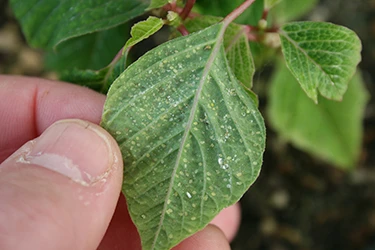
 Insect growth regulators (IGRs) are important weapons in the pest-control arsenal of greenhouse growers. These compounds generally mimic the action of specific hormones, thus disrupting the molting process or modifying growth and development of insect (or mite) pests. While IGRs don’t directly kill pests, they may interfere with the normal mechanisms of development, leading to pests dying before they reach the adult stage.
Insect growth regulators (IGRs) are important weapons in the pest-control arsenal of greenhouse growers. These compounds generally mimic the action of specific hormones, thus disrupting the molting process or modifying growth and development of insect (or mite) pests. While IGRs don’t directly kill pests, they may interfere with the normal mechanisms of development, leading to pests dying before they reach the adult stage.
Due to their mode of activity, IGRs should always be incorporated into insecticide rotation programs in order to prevent insect pest populations from developing resistance.
Slow and steady killers
In general, IGRs kill insect pests within three to 14 days; however, the time required to kill an insect pest depends on the particular IGR, the target insect pest, and the life stage. Insect growth regulators reduce pest populations over time—not immediately. Some IGRs may cause insect pests to stop feeding before they die. In addition, certain IGRs may affect egg, larva, nymph, and/or pupa development. Insect growth regulators may inhibit metamorphosis (change in form) and also negatively affect female and male reproduction and egg viability. Insect growth regulators are mainly used to kill the young or immature stages of plant-feeding insects including caterpillars, fungus gnats, leafminers, mealybugs, scales, shoreflies, thrips, and whiteflies. This is why application timing is critical.The short residual activity of IGRs, and the fact that their longevity may be impacted by exposure to ultra-violet (UV) light, means that repeat applications are usually required.
Three categories
IGRs may be placed into three distinct categories based on mode of action, including 1) juvenile hormone mimics or analogs (agonists), 2) ecdysone antagonists, and 3) chitin synthesis inhibitors. Juvenile hormone mimics or analogs arrest development, thus preventing completioin of their life cycle.
Examples of juvenile hormone mimics include fenoxycarb (Preclude), kinoprene (Enstar AQ), and pyriproxyfen (Distance). Ecdysone antagonists interfere with or disrupt the molting process of insect pests by inhibiting metabolism of the molting hormone—ecdysone. An example of an ecdysone antagonist is azadirachtin, which is the active ingredient in a number of commercially available products such as Azatin, Ornazin, Molt-X, AzaGuard, Azatrol, and Aza-Direct. Chitin synthesis inhibitors interfere with enzymes, during the molting process, that stimulate synthesis and formation of chitin, which is an essential component of an insect’s exoskeleton (skin). As a result, insect pests fail to reach adulthood because they die in the immature stage, or they mature into sterile adults (male and/or female). Examples of chitin synthesis inhibitors include buprofezin (Talus), cyromazine (Citation), diflubenzuron (Adept), etoxazole (TetraSan), and novaluron (Pedestal).
It is important to note that there are distinct differences among some of the chitin synthesis inhibitors in regards to their activity on target insect pests. For example, diflubenzuron (Adept) directly inhibits the production of chitin, which is a protein-like compound responsible for the strength and resilience of the exocuticle (middle layer of the cuticle). Buprofezin (Talus) however, prevents certain hormones from decreasing during initial molting resulting in improper digestion of the old cuticle, which prevents proper development of the new cuticle. Cyromazine (Citation) causes the cuticle to be abnormally rigid (hard) resulting in decreased elasticity, which reduces the ability of insect pests to move and feed. In addition, there is a mite growth regulator, etoxazole that also is a chitin synthesis inhibitor. Etoxazole (TetraSan) is a compound that inhibits the molting process during mite development. It is active on the eggs, larvae, and nymphs with no direct effects on adult mites.
Although IGRs are generally only active on the young stages of insect pests, it has been demonstrated that IGRs may indirectly affect the adult stages by reducing reproduction or egg viability. Egg viability is defined as those eggs that hatch into live young. IGRs may also suppress reproduction by preventing the formation of ovaries in the adult female. Consult the label to determine those IGRs that have indirect effects on the adult stage of insect pests.
The fact that some IGRs indirectly impact the adult stages of certain insect pests is important in regards to pest management because this means that another developmental life stage may be negatively affected. Suppressing reproduction of adult females may be helpful for long-term pest management because it may decrease the number of generations that occur during the cropping cycle. Furthermore, it may reduce the number of insecticide applications needed.
Impact on biologicals
IGRs are less directly harmful to biological control agents (such as parasitoids and predators) than conventional broad-spectrum pesticides (insecticides and miticides).
The overall effect of IGRs depends on 1) type of natural enemy (parasitoid or predator), 2) life stage (egg, larva, pupa, and adult) sensitivity, 3) application rate, 4) timing of application, and 5) type and mode of action of IGR used. Also, any harmful effects of IGRs may not be associated with the active ingredient but may be related to the inert ingredients such as adjuvants, carriers or solvents in the formulation.
Timing of application is important when using IGRs, as the susceptible life stage(s) must be present in order for IGRs to effectively suppress insect (and mite) pest populations. Insect growth regulators must be applied early in the crop production cycle or when insect pests are first detected. They are less effective when over-lapping generations of insect pests occur due to the presence of different life stages.
Bears repeating
Due to their mode of activity, IGRs should always be incorporated into insecticide rotation programs in order to prevent insect pest populations from developing resistance.
Raymond A. Cloyd, is a professor and extension specialist in Horticultural Entomology/IPM at Kansas State University - Dept. of Entomology.

Explore the August 2014 Issue
Check out more from this issue and find your next story to read.
Latest from Greenhouse Management
- Meet the Next Gen: Gabriella Blair, Star Roses and Plants
- Leading Women of Horticulture: Katie Dubow, Garden Media Group, and Aubry Field, Lizzy Blossom
- Showing up at your horticulture business as your whole self
- Leading women of Greenhouse Management
- USDA fires experts on invasive pests, including Asian citrus psyllid, chilli thrips
- Farwest Show calls for 2025 New Varieties Showcase entries
- Leading Women of Horticulture: Arden Pontasch, North Creek Nurseries
- Leading Women of Horticulture: Emily Showalter, Willoway Nurseries






